Analysis of Safeguarding Policies from Care Workers' Perspective
VerifiedAdded on 2019/12/03
|22
|3902
|187
Project
AI Summary
This research project critically analyzes safeguarding policies and procedures for service users, specifically focusing on children, from the perspective of care workers in the UK. The study explores various types of abuse faced by children, including physical, emotional, and sexual abuse, and the impact of family culture and harmful substances. The research employs both primary and secondary data collection methods, including interviews with care workers, literature reviews, and analysis of existing policies. The findings reveal care workers' perspectives on the effectiveness of current safeguarding measures and their satisfaction levels. The project identifies key issues such as family culture and substance abuse as significant harms and explores recommendations for improving safeguarding practices. The research aims to determine the types of abuse faced by children, evaluate existing safeguarding policies and procedures, and propose new strategies for care workers to better protect children in their own homes. The research concludes with recommendations for enhancing safeguarding practices and identifies areas for future research.
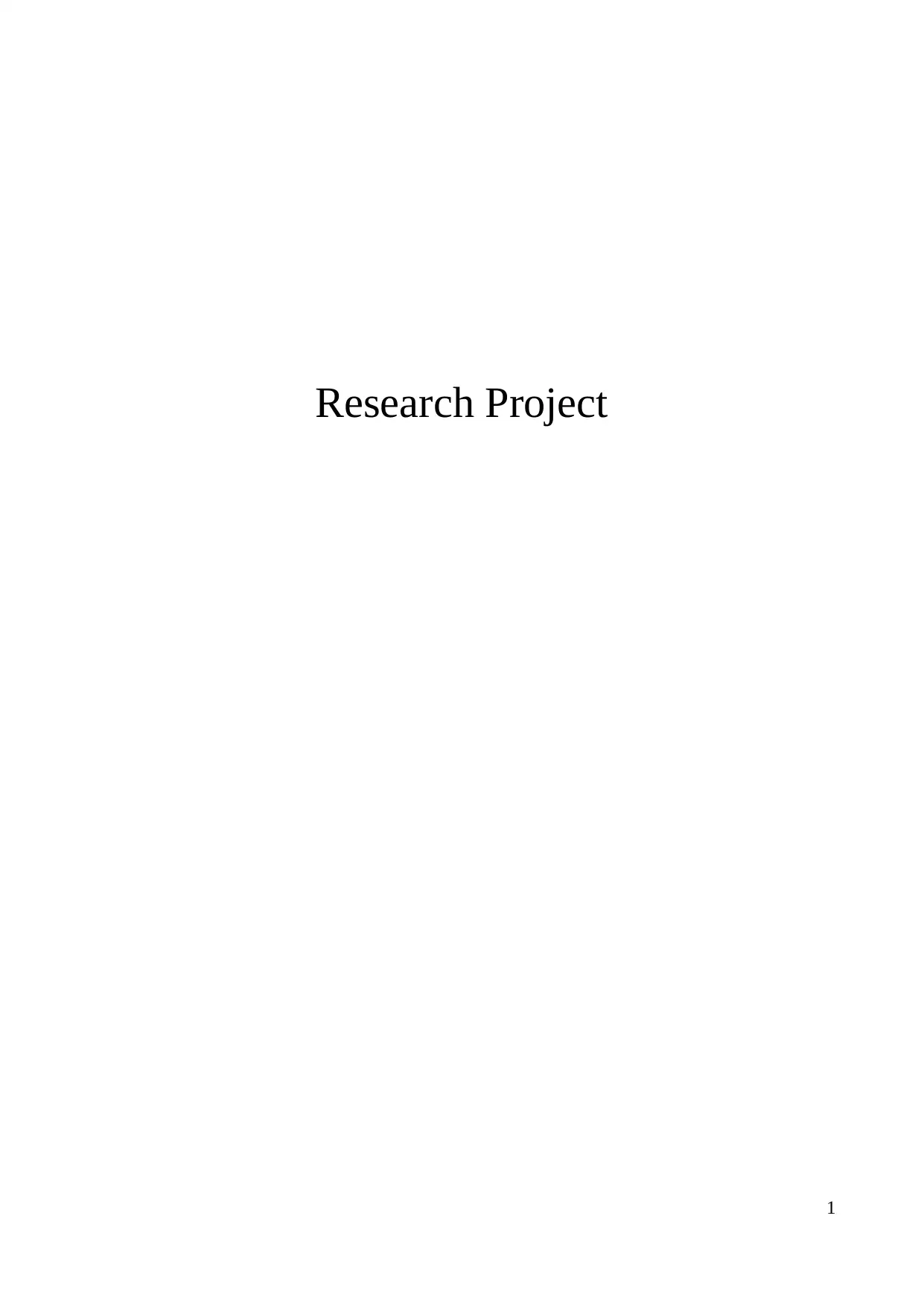
Research Project
1
1
Paraphrase This Document
Need a fresh take? Get an instant paraphrase of this document with our AI Paraphraser
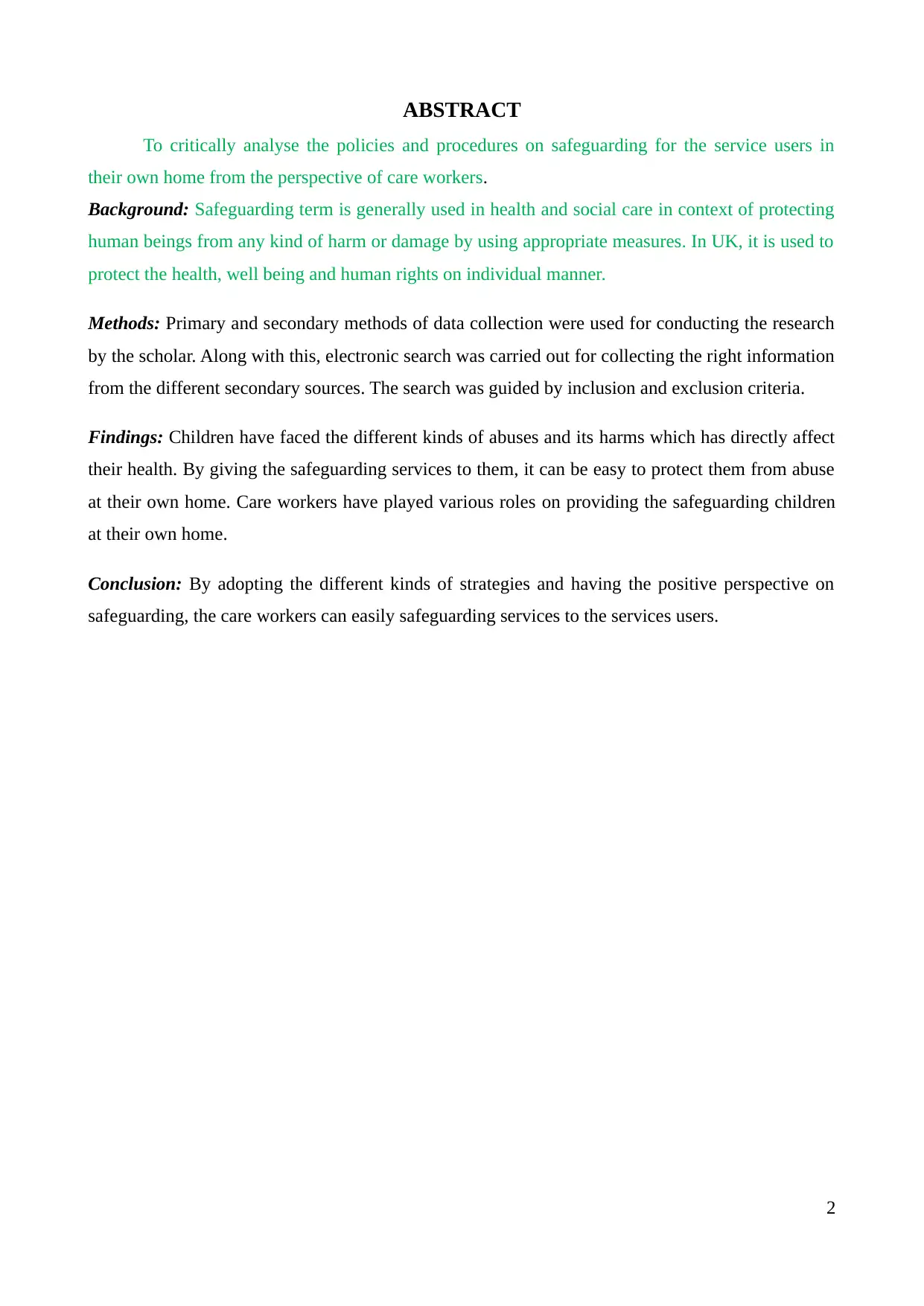
ABSTRACT
To critically analyse the policies and procedures on safeguarding for the service users in
their own home from the perspective of care workers.
Background: Safeguarding term is generally used in health and social care in context of protecting
human beings from any kind of harm or damage by using appropriate measures. In UK, it is used to
protect the health, well being and human rights on individual manner.
Methods: Primary and secondary methods of data collection were used for conducting the research
by the scholar. Along with this, electronic search was carried out for collecting the right information
from the different secondary sources. The search was guided by inclusion and exclusion criteria.
Findings: Children have faced the different kinds of abuses and its harms which has directly affect
their health. By giving the safeguarding services to them, it can be easy to protect them from abuse
at their own home. Care workers have played various roles on providing the safeguarding children
at their own home.
Conclusion: By adopting the different kinds of strategies and having the positive perspective on
safeguarding, the care workers can easily safeguarding services to the services users.
2
To critically analyse the policies and procedures on safeguarding for the service users in
their own home from the perspective of care workers.
Background: Safeguarding term is generally used in health and social care in context of protecting
human beings from any kind of harm or damage by using appropriate measures. In UK, it is used to
protect the health, well being and human rights on individual manner.
Methods: Primary and secondary methods of data collection were used for conducting the research
by the scholar. Along with this, electronic search was carried out for collecting the right information
from the different secondary sources. The search was guided by inclusion and exclusion criteria.
Findings: Children have faced the different kinds of abuses and its harms which has directly affect
their health. By giving the safeguarding services to them, it can be easy to protect them from abuse
at their own home. Care workers have played various roles on providing the safeguarding children
at their own home.
Conclusion: By adopting the different kinds of strategies and having the positive perspective on
safeguarding, the care workers can easily safeguarding services to the services users.
2
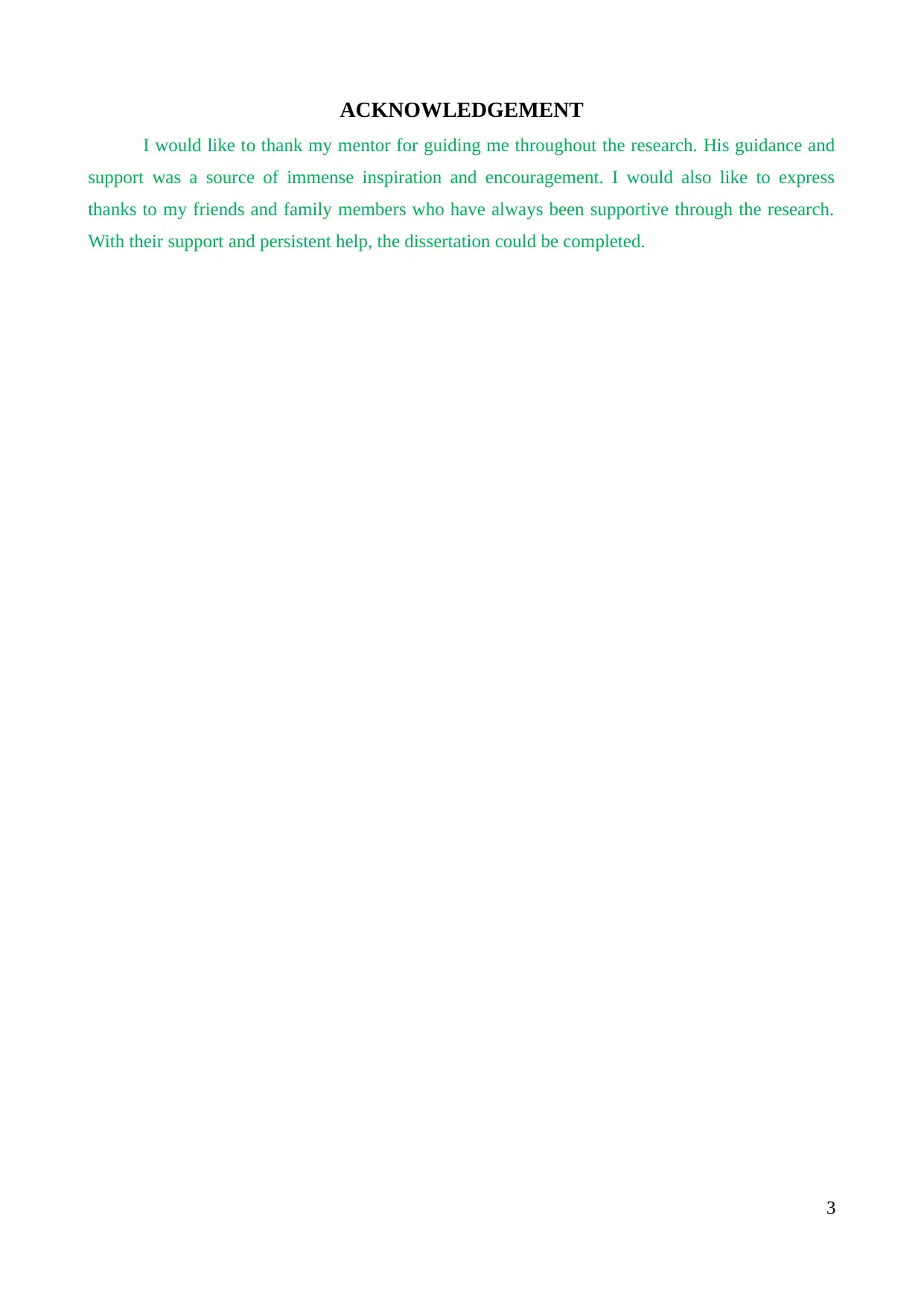
ACKNOWLEDGEMENT
I would like to thank my mentor for guiding me throughout the research. His guidance and
support was a source of immense inspiration and encouragement. I would also like to express
thanks to my friends and family members who have always been supportive through the research.
With their support and persistent help, the dissertation could be completed.
3
I would like to thank my mentor for guiding me throughout the research. His guidance and
support was a source of immense inspiration and encouragement. I would also like to express
thanks to my friends and family members who have always been supportive through the research.
With their support and persistent help, the dissertation could be completed.
3
⊘ This is a preview!⊘
Do you want full access?
Subscribe today to unlock all pages.

Trusted by 1+ million students worldwide
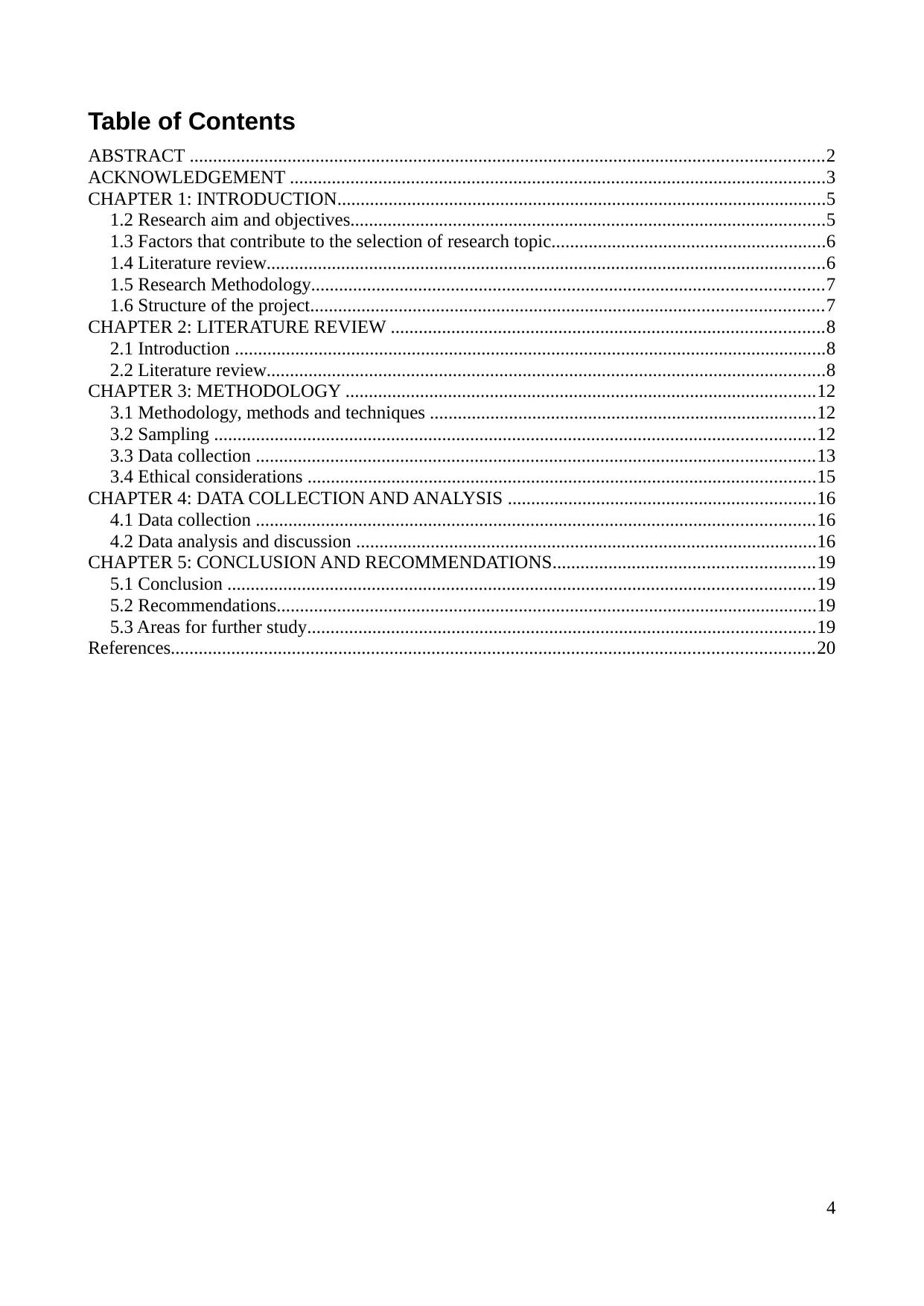
Table of Contents
ABSTRACT ........................................................................................................................................2
ACKNOWLEDGEMENT ...................................................................................................................3
CHAPTER 1: INTRODUCTION.........................................................................................................5
1.2 Research aim and objectives......................................................................................................5
1.3 Factors that contribute to the selection of research topic...........................................................6
1.4 Literature review........................................................................................................................6
1.5 Research Methodology..............................................................................................................7
1.6 Structure of the project..............................................................................................................7
CHAPTER 2: LITERATURE REVIEW .............................................................................................8
2.1 Introduction ...............................................................................................................................8
2.2 Literature review........................................................................................................................8
CHAPTER 3: METHODOLOGY .....................................................................................................12
3.1 Methodology, methods and techniques ...................................................................................12
3.2 Sampling .................................................................................................................................12
3.3 Data collection ........................................................................................................................13
3.4 Ethical considerations .............................................................................................................15
CHAPTER 4: DATA COLLECTION AND ANALYSIS ..................................................................16
4.1 Data collection ........................................................................................................................16
4.2 Data analysis and discussion ...................................................................................................16
CHAPTER 5: CONCLUSION AND RECOMMENDATIONS........................................................19
5.1 Conclusion ..............................................................................................................................19
5.2 Recommendations....................................................................................................................19
5.3 Areas for further study.............................................................................................................19
References..........................................................................................................................................20
4
ABSTRACT ........................................................................................................................................2
ACKNOWLEDGEMENT ...................................................................................................................3
CHAPTER 1: INTRODUCTION.........................................................................................................5
1.2 Research aim and objectives......................................................................................................5
1.3 Factors that contribute to the selection of research topic...........................................................6
1.4 Literature review........................................................................................................................6
1.5 Research Methodology..............................................................................................................7
1.6 Structure of the project..............................................................................................................7
CHAPTER 2: LITERATURE REVIEW .............................................................................................8
2.1 Introduction ...............................................................................................................................8
2.2 Literature review........................................................................................................................8
CHAPTER 3: METHODOLOGY .....................................................................................................12
3.1 Methodology, methods and techniques ...................................................................................12
3.2 Sampling .................................................................................................................................12
3.3 Data collection ........................................................................................................................13
3.4 Ethical considerations .............................................................................................................15
CHAPTER 4: DATA COLLECTION AND ANALYSIS ..................................................................16
4.1 Data collection ........................................................................................................................16
4.2 Data analysis and discussion ...................................................................................................16
CHAPTER 5: CONCLUSION AND RECOMMENDATIONS........................................................19
5.1 Conclusion ..............................................................................................................................19
5.2 Recommendations....................................................................................................................19
5.3 Areas for further study.............................................................................................................19
References..........................................................................................................................................20
4
Paraphrase This Document
Need a fresh take? Get an instant paraphrase of this document with our AI Paraphraser
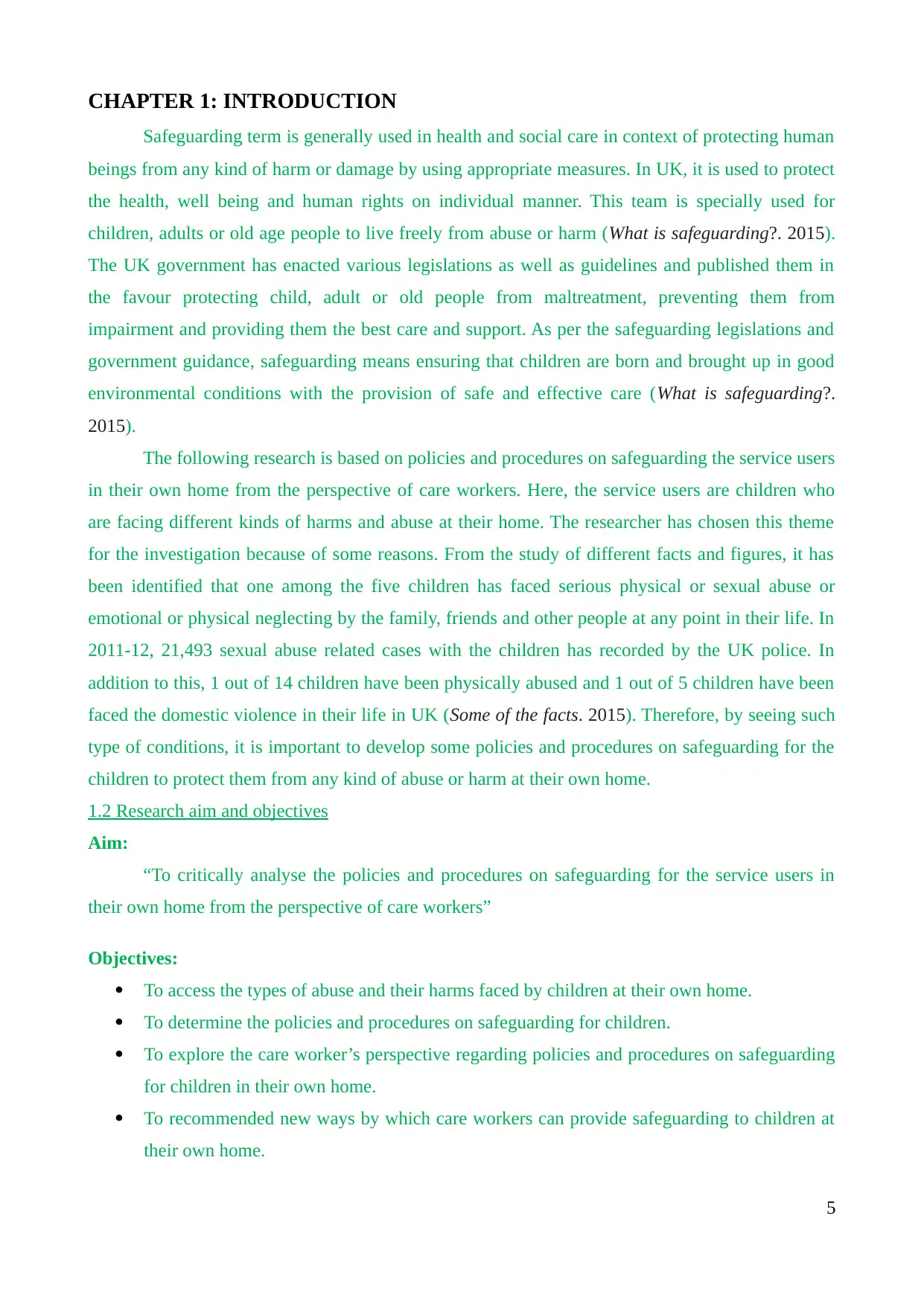
CHAPTER 1: INTRODUCTION
Safeguarding term is generally used in health and social care in context of protecting human
beings from any kind of harm or damage by using appropriate measures. In UK, it is used to protect
the health, well being and human rights on individual manner. This team is specially used for
children, adults or old age people to live freely from abuse or harm (What is safeguarding?. 2015).
The UK government has enacted various legislations as well as guidelines and published them in
the favour protecting child, adult or old people from maltreatment, preventing them from
impairment and providing them the best care and support. As per the safeguarding legislations and
government guidance, safeguarding means ensuring that children are born and brought up in good
environmental conditions with the provision of safe and effective care (What is safeguarding?.
2015).
The following research is based on policies and procedures on safeguarding the service users
in their own home from the perspective of care workers. Here, the service users are children who
are facing different kinds of harms and abuse at their home. The researcher has chosen this theme
for the investigation because of some reasons. From the study of different facts and figures, it has
been identified that one among the five children has faced serious physical or sexual abuse or
emotional or physical neglecting by the family, friends and other people at any point in their life. In
2011-12, 21,493 sexual abuse related cases with the children has recorded by the UK police. In
addition to this, 1 out of 14 children have been physically abused and 1 out of 5 children have been
faced the domestic violence in their life in UK (Some of the facts. 2015). Therefore, by seeing such
type of conditions, it is important to develop some policies and procedures on safeguarding for the
children to protect them from any kind of abuse or harm at their own home.
1.2 Research aim and objectives
Aim:
“To critically analyse the policies and procedures on safeguarding for the service users in
their own home from the perspective of care workers”
Objectives:
To access the types of abuse and their harms faced by children at their own home.
To determine the policies and procedures on safeguarding for children.
To explore the care worker’s perspective regarding policies and procedures on safeguarding
for children in their own home.
To recommended new ways by which care workers can provide safeguarding to children at
their own home.
5
Safeguarding term is generally used in health and social care in context of protecting human
beings from any kind of harm or damage by using appropriate measures. In UK, it is used to protect
the health, well being and human rights on individual manner. This team is specially used for
children, adults or old age people to live freely from abuse or harm (What is safeguarding?. 2015).
The UK government has enacted various legislations as well as guidelines and published them in
the favour protecting child, adult or old people from maltreatment, preventing them from
impairment and providing them the best care and support. As per the safeguarding legislations and
government guidance, safeguarding means ensuring that children are born and brought up in good
environmental conditions with the provision of safe and effective care (What is safeguarding?.
2015).
The following research is based on policies and procedures on safeguarding the service users
in their own home from the perspective of care workers. Here, the service users are children who
are facing different kinds of harms and abuse at their home. The researcher has chosen this theme
for the investigation because of some reasons. From the study of different facts and figures, it has
been identified that one among the five children has faced serious physical or sexual abuse or
emotional or physical neglecting by the family, friends and other people at any point in their life. In
2011-12, 21,493 sexual abuse related cases with the children has recorded by the UK police. In
addition to this, 1 out of 14 children have been physically abused and 1 out of 5 children have been
faced the domestic violence in their life in UK (Some of the facts. 2015). Therefore, by seeing such
type of conditions, it is important to develop some policies and procedures on safeguarding for the
children to protect them from any kind of abuse or harm at their own home.
1.2 Research aim and objectives
Aim:
“To critically analyse the policies and procedures on safeguarding for the service users in
their own home from the perspective of care workers”
Objectives:
To access the types of abuse and their harms faced by children at their own home.
To determine the policies and procedures on safeguarding for children.
To explore the care worker’s perspective regarding policies and procedures on safeguarding
for children in their own home.
To recommended new ways by which care workers can provide safeguarding to children at
their own home.
5
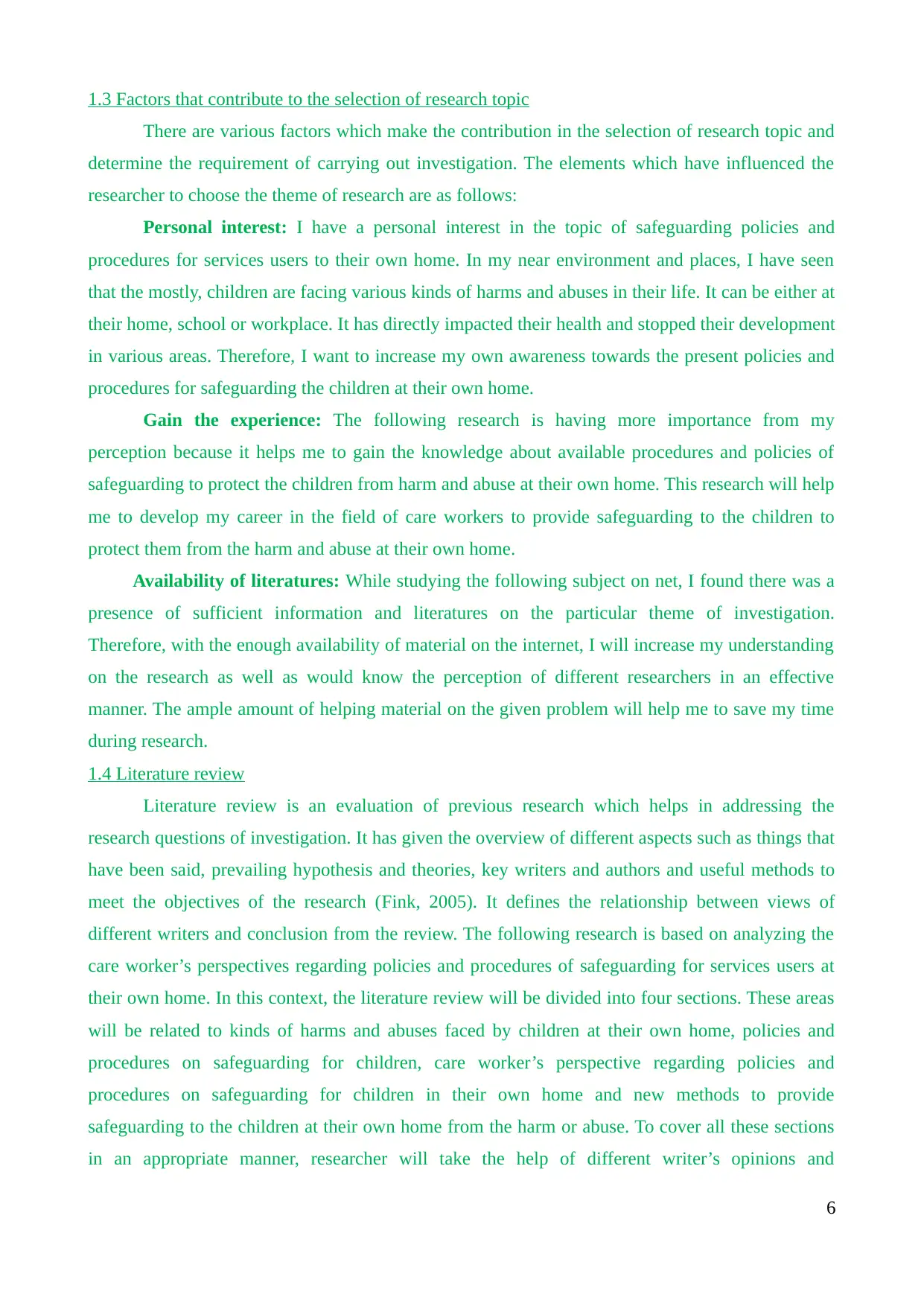
1.3 Factors that contribute to the selection of research topic
There are various factors which make the contribution in the selection of research topic and
determine the requirement of carrying out investigation. The elements which have influenced the
researcher to choose the theme of research are as follows:
Personal interest: I have a personal interest in the topic of safeguarding policies and
procedures for services users to their own home. In my near environment and places, I have seen
that the mostly, children are facing various kinds of harms and abuses in their life. It can be either at
their home, school or workplace. It has directly impacted their health and stopped their development
in various areas. Therefore, I want to increase my own awareness towards the present policies and
procedures for safeguarding the children at their own home.
Gain the experience: The following research is having more importance from my
perception because it helps me to gain the knowledge about available procedures and policies of
safeguarding to protect the children from harm and abuse at their own home. This research will help
me to develop my career in the field of care workers to provide safeguarding to the children to
protect them from the harm and abuse at their own home.
Availability of literatures: While studying the following subject on net, I found there was a
presence of sufficient information and literatures on the particular theme of investigation.
Therefore, with the enough availability of material on the internet, I will increase my understanding
on the research as well as would know the perception of different researchers in an effective
manner. The ample amount of helping material on the given problem will help me to save my time
during research.
1.4 Literature review
Literature review is an evaluation of previous research which helps in addressing the
research questions of investigation. It has given the overview of different aspects such as things that
have been said, prevailing hypothesis and theories, key writers and authors and useful methods to
meet the objectives of the research (Fink, 2005). It defines the relationship between views of
different writers and conclusion from the review. The following research is based on analyzing the
care worker’s perspectives regarding policies and procedures of safeguarding for services users at
their own home. In this context, the literature review will be divided into four sections. These areas
will be related to kinds of harms and abuses faced by children at their own home, policies and
procedures on safeguarding for children, care worker’s perspective regarding policies and
procedures on safeguarding for children in their own home and new methods to provide
safeguarding to the children at their own home from the harm or abuse. To cover all these sections
in an appropriate manner, researcher will take the help of different writer’s opinions and
6
There are various factors which make the contribution in the selection of research topic and
determine the requirement of carrying out investigation. The elements which have influenced the
researcher to choose the theme of research are as follows:
Personal interest: I have a personal interest in the topic of safeguarding policies and
procedures for services users to their own home. In my near environment and places, I have seen
that the mostly, children are facing various kinds of harms and abuses in their life. It can be either at
their home, school or workplace. It has directly impacted their health and stopped their development
in various areas. Therefore, I want to increase my own awareness towards the present policies and
procedures for safeguarding the children at their own home.
Gain the experience: The following research is having more importance from my
perception because it helps me to gain the knowledge about available procedures and policies of
safeguarding to protect the children from harm and abuse at their own home. This research will help
me to develop my career in the field of care workers to provide safeguarding to the children to
protect them from the harm and abuse at their own home.
Availability of literatures: While studying the following subject on net, I found there was a
presence of sufficient information and literatures on the particular theme of investigation.
Therefore, with the enough availability of material on the internet, I will increase my understanding
on the research as well as would know the perception of different researchers in an effective
manner. The ample amount of helping material on the given problem will help me to save my time
during research.
1.4 Literature review
Literature review is an evaluation of previous research which helps in addressing the
research questions of investigation. It has given the overview of different aspects such as things that
have been said, prevailing hypothesis and theories, key writers and authors and useful methods to
meet the objectives of the research (Fink, 2005). It defines the relationship between views of
different writers and conclusion from the review. The following research is based on analyzing the
care worker’s perspectives regarding policies and procedures of safeguarding for services users at
their own home. In this context, the literature review will be divided into four sections. These areas
will be related to kinds of harms and abuses faced by children at their own home, policies and
procedures on safeguarding for children, care worker’s perspective regarding policies and
procedures on safeguarding for children in their own home and new methods to provide
safeguarding to the children at their own home from the harm or abuse. To cover all these sections
in an appropriate manner, researcher will take the help of different writer’s opinions and
6
⊘ This is a preview!⊘
Do you want full access?
Subscribe today to unlock all pages.

Trusted by 1+ million students worldwide
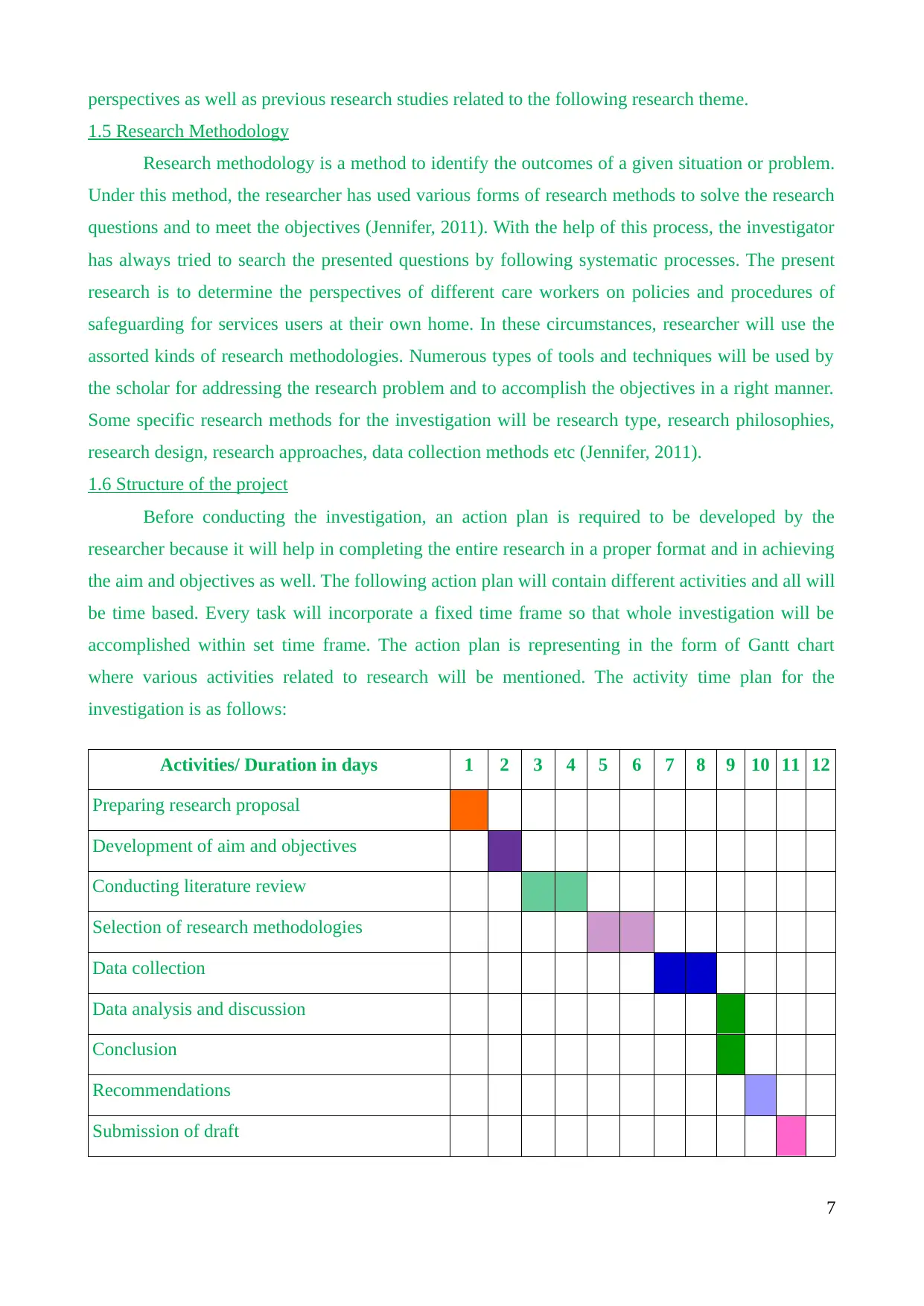
perspectives as well as previous research studies related to the following research theme.
1.5 Research Methodology
Research methodology is a method to identify the outcomes of a given situation or problem.
Under this method, the researcher has used various forms of research methods to solve the research
questions and to meet the objectives (Jennifer, 2011). With the help of this process, the investigator
has always tried to search the presented questions by following systematic processes. The present
research is to determine the perspectives of different care workers on policies and procedures of
safeguarding for services users at their own home. In these circumstances, researcher will use the
assorted kinds of research methodologies. Numerous types of tools and techniques will be used by
the scholar for addressing the research problem and to accomplish the objectives in a right manner.
Some specific research methods for the investigation will be research type, research philosophies,
research design, research approaches, data collection methods etc (Jennifer, 2011).
1.6 Structure of the project
Before conducting the investigation, an action plan is required to be developed by the
researcher because it will help in completing the entire research in a proper format and in achieving
the aim and objectives as well. The following action plan will contain different activities and all will
be time based. Every task will incorporate a fixed time frame so that whole investigation will be
accomplished within set time frame. The action plan is representing in the form of Gantt chart
where various activities related to research will be mentioned. The activity time plan for the
investigation is as follows:
Activities/ Duration in days 1 2 3 4 5 6 7 8 9 10 11 12
Preparing research proposal
Development of aim and objectives
Conducting literature review
Selection of research methodologies
Data collection
Data analysis and discussion
Conclusion
Recommendations
Submission of draft
7
1.5 Research Methodology
Research methodology is a method to identify the outcomes of a given situation or problem.
Under this method, the researcher has used various forms of research methods to solve the research
questions and to meet the objectives (Jennifer, 2011). With the help of this process, the investigator
has always tried to search the presented questions by following systematic processes. The present
research is to determine the perspectives of different care workers on policies and procedures of
safeguarding for services users at their own home. In these circumstances, researcher will use the
assorted kinds of research methodologies. Numerous types of tools and techniques will be used by
the scholar for addressing the research problem and to accomplish the objectives in a right manner.
Some specific research methods for the investigation will be research type, research philosophies,
research design, research approaches, data collection methods etc (Jennifer, 2011).
1.6 Structure of the project
Before conducting the investigation, an action plan is required to be developed by the
researcher because it will help in completing the entire research in a proper format and in achieving
the aim and objectives as well. The following action plan will contain different activities and all will
be time based. Every task will incorporate a fixed time frame so that whole investigation will be
accomplished within set time frame. The action plan is representing in the form of Gantt chart
where various activities related to research will be mentioned. The activity time plan for the
investigation is as follows:
Activities/ Duration in days 1 2 3 4 5 6 7 8 9 10 11 12
Preparing research proposal
Development of aim and objectives
Conducting literature review
Selection of research methodologies
Data collection
Data analysis and discussion
Conclusion
Recommendations
Submission of draft
7
Paraphrase This Document
Need a fresh take? Get an instant paraphrase of this document with our AI Paraphraser
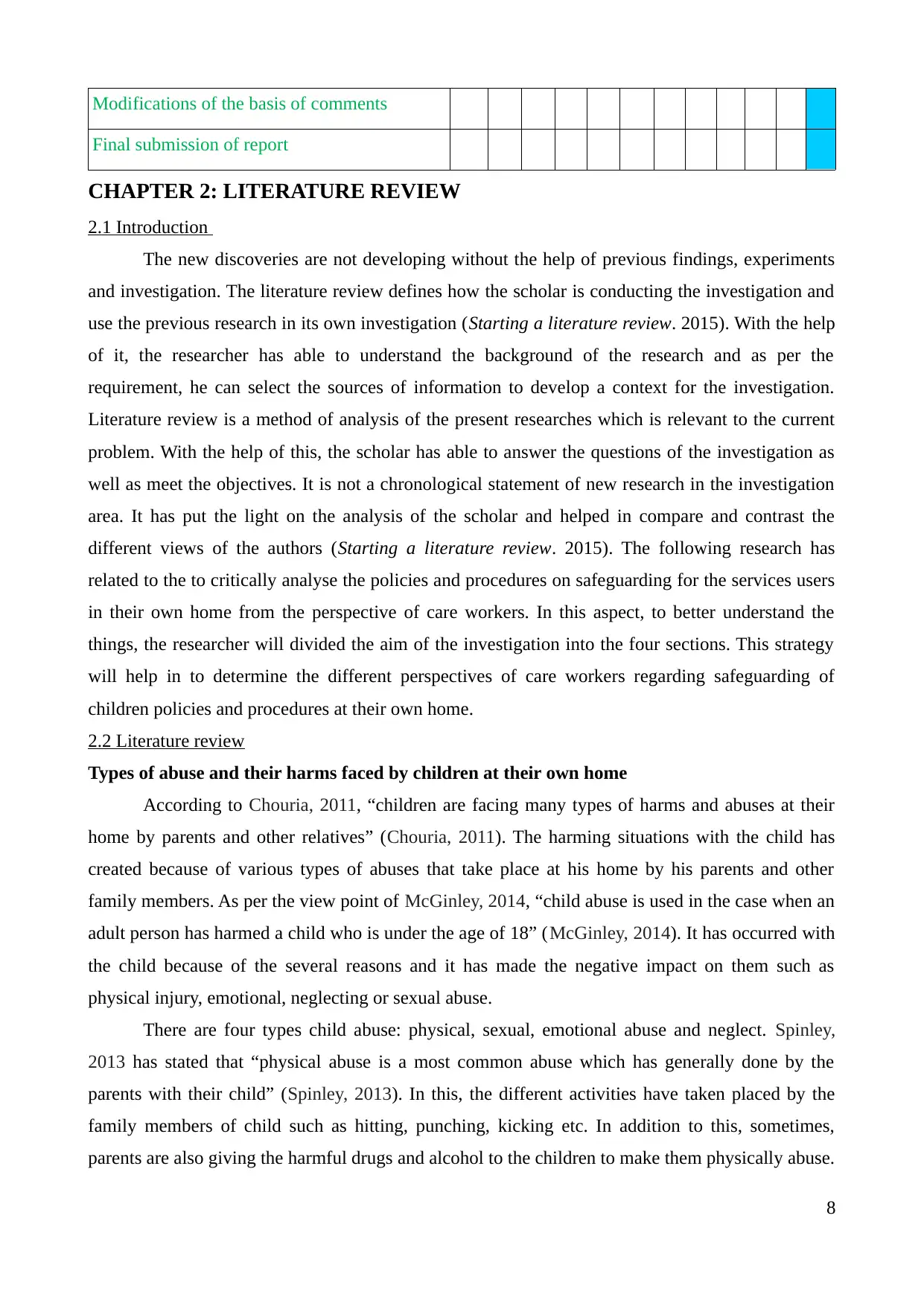
Modifications of the basis of comments
Final submission of report
CHAPTER 2: LITERATURE REVIEW
2.1 Introduction
The new discoveries are not developing without the help of previous findings, experiments
and investigation. The literature review defines how the scholar is conducting the investigation and
use the previous research in its own investigation (Starting a literature review. 2015). With the help
of it, the researcher has able to understand the background of the research and as per the
requirement, he can select the sources of information to develop a context for the investigation.
Literature review is a method of analysis of the present researches which is relevant to the current
problem. With the help of this, the scholar has able to answer the questions of the investigation as
well as meet the objectives. It is not a chronological statement of new research in the investigation
area. It has put the light on the analysis of the scholar and helped in compare and contrast the
different views of the authors (Starting a literature review. 2015). The following research has
related to the to critically analyse the policies and procedures on safeguarding for the services users
in their own home from the perspective of care workers. In this aspect, to better understand the
things, the researcher will divided the aim of the investigation into the four sections. This strategy
will help in to determine the different perspectives of care workers regarding safeguarding of
children policies and procedures at their own home.
2.2 Literature review
Types of abuse and their harms faced by children at their own home
According to Chouria, 2011, “children are facing many types of harms and abuses at their
home by parents and other relatives” (Chouria, 2011). The harming situations with the child has
created because of various types of abuses that take place at his home by his parents and other
family members. As per the view point of McGinley, 2014, “child abuse is used in the case when an
adult person has harmed a child who is under the age of 18” (McGinley, 2014). It has occurred with
the child because of the several reasons and it has made the negative impact on them such as
physical injury, emotional, neglecting or sexual abuse.
There are four types child abuse: physical, sexual, emotional abuse and neglect. Spinley,
2013 has stated that “physical abuse is a most common abuse which has generally done by the
parents with their child” (Spinley, 2013). In this, the different activities have taken placed by the
family members of child such as hitting, punching, kicking etc. In addition to this, sometimes,
parents are also giving the harmful drugs and alcohol to the children to make them physically abuse.
8
Final submission of report
CHAPTER 2: LITERATURE REVIEW
2.1 Introduction
The new discoveries are not developing without the help of previous findings, experiments
and investigation. The literature review defines how the scholar is conducting the investigation and
use the previous research in its own investigation (Starting a literature review. 2015). With the help
of it, the researcher has able to understand the background of the research and as per the
requirement, he can select the sources of information to develop a context for the investigation.
Literature review is a method of analysis of the present researches which is relevant to the current
problem. With the help of this, the scholar has able to answer the questions of the investigation as
well as meet the objectives. It is not a chronological statement of new research in the investigation
area. It has put the light on the analysis of the scholar and helped in compare and contrast the
different views of the authors (Starting a literature review. 2015). The following research has
related to the to critically analyse the policies and procedures on safeguarding for the services users
in their own home from the perspective of care workers. In this aspect, to better understand the
things, the researcher will divided the aim of the investigation into the four sections. This strategy
will help in to determine the different perspectives of care workers regarding safeguarding of
children policies and procedures at their own home.
2.2 Literature review
Types of abuse and their harms faced by children at their own home
According to Chouria, 2011, “children are facing many types of harms and abuses at their
home by parents and other relatives” (Chouria, 2011). The harming situations with the child has
created because of various types of abuses that take place at his home by his parents and other
family members. As per the view point of McGinley, 2014, “child abuse is used in the case when an
adult person has harmed a child who is under the age of 18” (McGinley, 2014). It has occurred with
the child because of the several reasons and it has made the negative impact on them such as
physical injury, emotional, neglecting or sexual abuse.
There are four types child abuse: physical, sexual, emotional abuse and neglect. Spinley,
2013 has stated that “physical abuse is a most common abuse which has generally done by the
parents with their child” (Spinley, 2013). In this, the different activities have taken placed by the
family members of child such as hitting, punching, kicking etc. In addition to this, sometimes,
parents are also giving the harmful drugs and alcohol to the children to make them physically abuse.
8
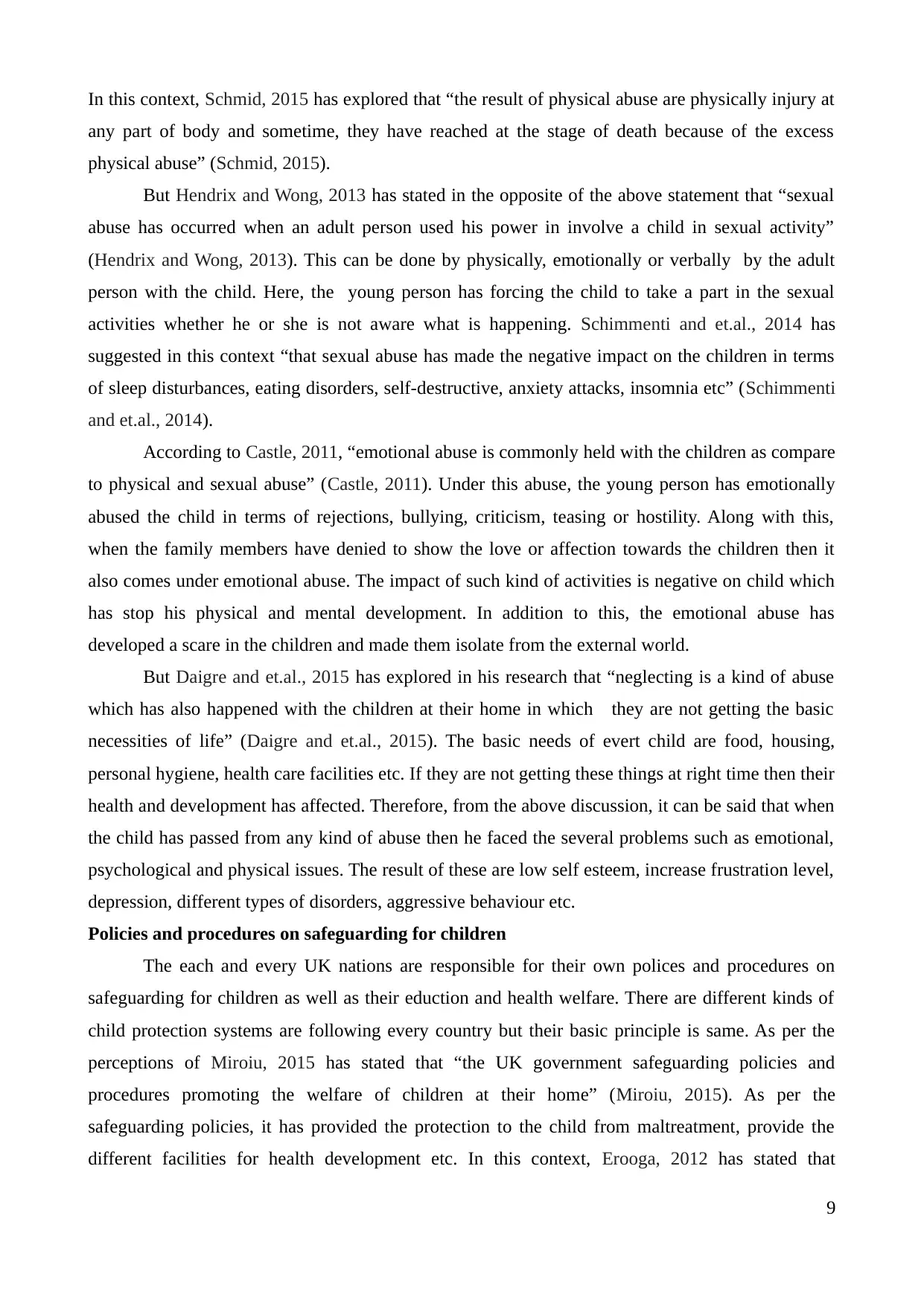
In this context, Schmid, 2015 has explored that “the result of physical abuse are physically injury at
any part of body and sometime, they have reached at the stage of death because of the excess
physical abuse” (Schmid, 2015).
But Hendrix and Wong, 2013 has stated in the opposite of the above statement that “sexual
abuse has occurred when an adult person used his power in involve a child in sexual activity”
(Hendrix and Wong, 2013). This can be done by physically, emotionally or verbally by the adult
person with the child. Here, the young person has forcing the child to take a part in the sexual
activities whether he or she is not aware what is happening. Schimmenti and et.al., 2014 has
suggested in this context “that sexual abuse has made the negative impact on the children in terms
of sleep disturbances, eating disorders, self-destructive, anxiety attacks, insomnia etc” (Schimmenti
and et.al., 2014).
According to Castle, 2011, “emotional abuse is commonly held with the children as compare
to physical and sexual abuse” (Castle, 2011). Under this abuse, the young person has emotionally
abused the child in terms of rejections, bullying, criticism, teasing or hostility. Along with this,
when the family members have denied to show the love or affection towards the children then it
also comes under emotional abuse. The impact of such kind of activities is negative on child which
has stop his physical and mental development. In addition to this, the emotional abuse has
developed a scare in the children and made them isolate from the external world.
But Daigre and et.al., 2015 has explored in his research that “neglecting is a kind of abuse
which has also happened with the children at their home in which they are not getting the basic
necessities of life” (Daigre and et.al., 2015). The basic needs of evert child are food, housing,
personal hygiene, health care facilities etc. If they are not getting these things at right time then their
health and development has affected. Therefore, from the above discussion, it can be said that when
the child has passed from any kind of abuse then he faced the several problems such as emotional,
psychological and physical issues. The result of these are low self esteem, increase frustration level,
depression, different types of disorders, aggressive behaviour etc.
Policies and procedures on safeguarding for children
The each and every UK nations are responsible for their own polices and procedures on
safeguarding for children as well as their eduction and health welfare. There are different kinds of
child protection systems are following every country but their basic principle is same. As per the
perceptions of Miroiu, 2015 has stated that “the UK government safeguarding policies and
procedures promoting the welfare of children at their home” (Miroiu, 2015). As per the
safeguarding policies, it has provided the protection to the child from maltreatment, provide the
different facilities for health development etc. In this context, Erooga, 2012 has stated that
9
any part of body and sometime, they have reached at the stage of death because of the excess
physical abuse” (Schmid, 2015).
But Hendrix and Wong, 2013 has stated in the opposite of the above statement that “sexual
abuse has occurred when an adult person used his power in involve a child in sexual activity”
(Hendrix and Wong, 2013). This can be done by physically, emotionally or verbally by the adult
person with the child. Here, the young person has forcing the child to take a part in the sexual
activities whether he or she is not aware what is happening. Schimmenti and et.al., 2014 has
suggested in this context “that sexual abuse has made the negative impact on the children in terms
of sleep disturbances, eating disorders, self-destructive, anxiety attacks, insomnia etc” (Schimmenti
and et.al., 2014).
According to Castle, 2011, “emotional abuse is commonly held with the children as compare
to physical and sexual abuse” (Castle, 2011). Under this abuse, the young person has emotionally
abused the child in terms of rejections, bullying, criticism, teasing or hostility. Along with this,
when the family members have denied to show the love or affection towards the children then it
also comes under emotional abuse. The impact of such kind of activities is negative on child which
has stop his physical and mental development. In addition to this, the emotional abuse has
developed a scare in the children and made them isolate from the external world.
But Daigre and et.al., 2015 has explored in his research that “neglecting is a kind of abuse
which has also happened with the children at their home in which they are not getting the basic
necessities of life” (Daigre and et.al., 2015). The basic needs of evert child are food, housing,
personal hygiene, health care facilities etc. If they are not getting these things at right time then their
health and development has affected. Therefore, from the above discussion, it can be said that when
the child has passed from any kind of abuse then he faced the several problems such as emotional,
psychological and physical issues. The result of these are low self esteem, increase frustration level,
depression, different types of disorders, aggressive behaviour etc.
Policies and procedures on safeguarding for children
The each and every UK nations are responsible for their own polices and procedures on
safeguarding for children as well as their eduction and health welfare. There are different kinds of
child protection systems are following every country but their basic principle is same. As per the
perceptions of Miroiu, 2015 has stated that “the UK government safeguarding policies and
procedures promoting the welfare of children at their home” (Miroiu, 2015). As per the
safeguarding policies, it has provided the protection to the child from maltreatment, provide the
different facilities for health development etc. In this context, Erooga, 2012 has stated that
9
⊘ This is a preview!⊘
Do you want full access?
Subscribe today to unlock all pages.

Trusted by 1+ million students worldwide
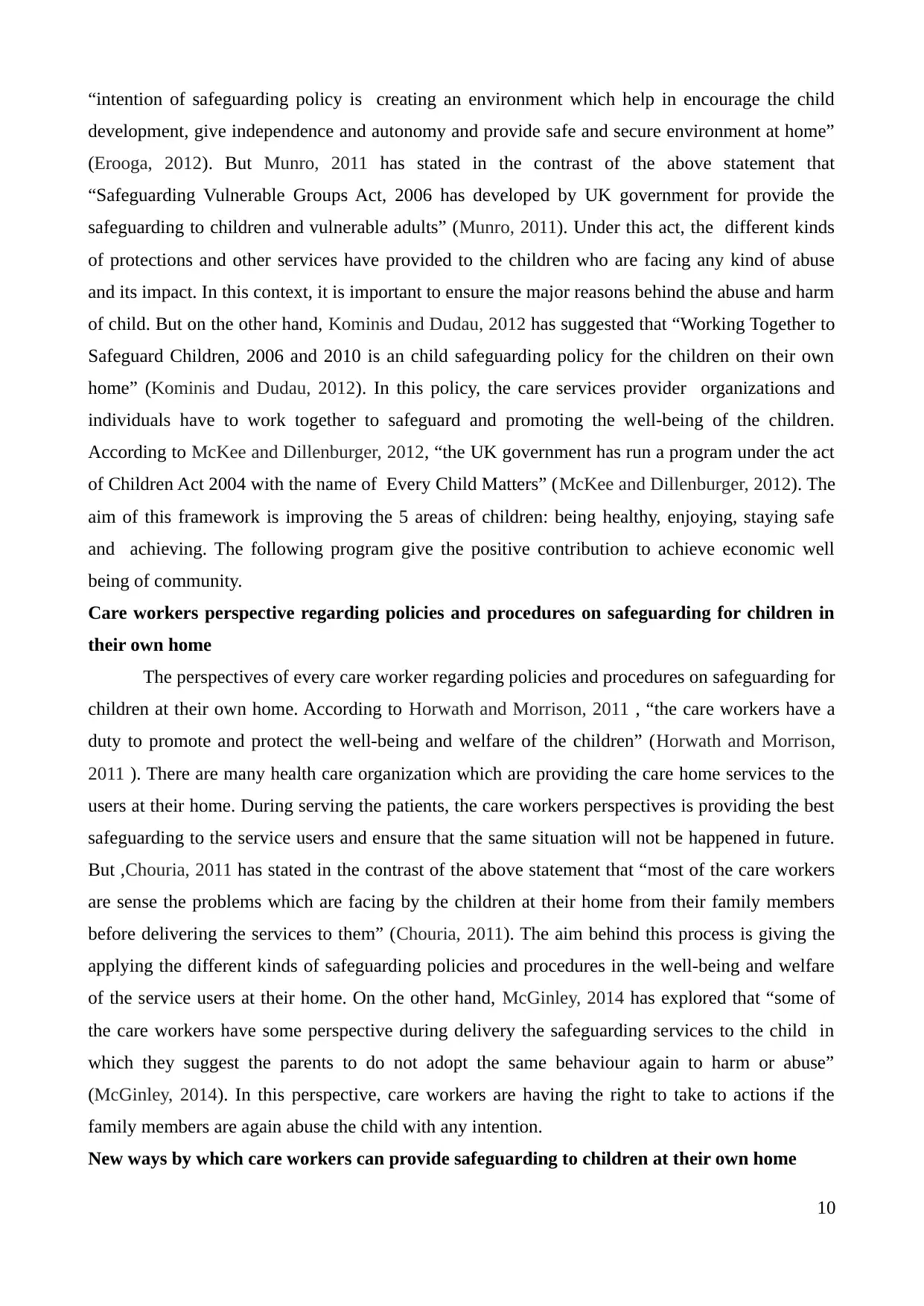
“intention of safeguarding policy is creating an environment which help in encourage the child
development, give independence and autonomy and provide safe and secure environment at home”
(Erooga, 2012). But Munro, 2011 has stated in the contrast of the above statement that
“Safeguarding Vulnerable Groups Act, 2006 has developed by UK government for provide the
safeguarding to children and vulnerable adults” (Munro, 2011). Under this act, the different kinds
of protections and other services have provided to the children who are facing any kind of abuse
and its impact. In this context, it is important to ensure the major reasons behind the abuse and harm
of child. But on the other hand, Kominis and Dudau, 2012 has suggested that “Working Together to
Safeguard Children, 2006 and 2010 is an child safeguarding policy for the children on their own
home” (Kominis and Dudau, 2012). In this policy, the care services provider organizations and
individuals have to work together to safeguard and promoting the well-being of the children.
According to McKee and Dillenburger, 2012, “the UK government has run a program under the act
of Children Act 2004 with the name of Every Child Matters” (McKee and Dillenburger, 2012). The
aim of this framework is improving the 5 areas of children: being healthy, enjoying, staying safe
and achieving. The following program give the positive contribution to achieve economic well
being of community.
Care workers perspective regarding policies and procedures on safeguarding for children in
their own home
The perspectives of every care worker regarding policies and procedures on safeguarding for
children at their own home. According to Horwath and Morrison, 2011 , “the care workers have a
duty to promote and protect the well-being and welfare of the children” (Horwath and Morrison,
2011 ). There are many health care organization which are providing the care home services to the
users at their home. During serving the patients, the care workers perspectives is providing the best
safeguarding to the service users and ensure that the same situation will not be happened in future.
But ,Chouria, 2011 has stated in the contrast of the above statement that “most of the care workers
are sense the problems which are facing by the children at their home from their family members
before delivering the services to them” (Chouria, 2011). The aim behind this process is giving the
applying the different kinds of safeguarding policies and procedures in the well-being and welfare
of the service users at their home. On the other hand, McGinley, 2014 has explored that “some of
the care workers have some perspective during delivery the safeguarding services to the child in
which they suggest the parents to do not adopt the same behaviour again to harm or abuse”
(McGinley, 2014). In this perspective, care workers are having the right to take to actions if the
family members are again abuse the child with any intention.
New ways by which care workers can provide safeguarding to children at their own home
10
development, give independence and autonomy and provide safe and secure environment at home”
(Erooga, 2012). But Munro, 2011 has stated in the contrast of the above statement that
“Safeguarding Vulnerable Groups Act, 2006 has developed by UK government for provide the
safeguarding to children and vulnerable adults” (Munro, 2011). Under this act, the different kinds
of protections and other services have provided to the children who are facing any kind of abuse
and its impact. In this context, it is important to ensure the major reasons behind the abuse and harm
of child. But on the other hand, Kominis and Dudau, 2012 has suggested that “Working Together to
Safeguard Children, 2006 and 2010 is an child safeguarding policy for the children on their own
home” (Kominis and Dudau, 2012). In this policy, the care services provider organizations and
individuals have to work together to safeguard and promoting the well-being of the children.
According to McKee and Dillenburger, 2012, “the UK government has run a program under the act
of Children Act 2004 with the name of Every Child Matters” (McKee and Dillenburger, 2012). The
aim of this framework is improving the 5 areas of children: being healthy, enjoying, staying safe
and achieving. The following program give the positive contribution to achieve economic well
being of community.
Care workers perspective regarding policies and procedures on safeguarding for children in
their own home
The perspectives of every care worker regarding policies and procedures on safeguarding for
children at their own home. According to Horwath and Morrison, 2011 , “the care workers have a
duty to promote and protect the well-being and welfare of the children” (Horwath and Morrison,
2011 ). There are many health care organization which are providing the care home services to the
users at their home. During serving the patients, the care workers perspectives is providing the best
safeguarding to the service users and ensure that the same situation will not be happened in future.
But ,Chouria, 2011 has stated in the contrast of the above statement that “most of the care workers
are sense the problems which are facing by the children at their home from their family members
before delivering the services to them” (Chouria, 2011). The aim behind this process is giving the
applying the different kinds of safeguarding policies and procedures in the well-being and welfare
of the service users at their home. On the other hand, McGinley, 2014 has explored that “some of
the care workers have some perspective during delivery the safeguarding services to the child in
which they suggest the parents to do not adopt the same behaviour again to harm or abuse”
(McGinley, 2014). In this perspective, care workers are having the right to take to actions if the
family members are again abuse the child with any intention.
New ways by which care workers can provide safeguarding to children at their own home
10
Paraphrase This Document
Need a fresh take? Get an instant paraphrase of this document with our AI Paraphraser
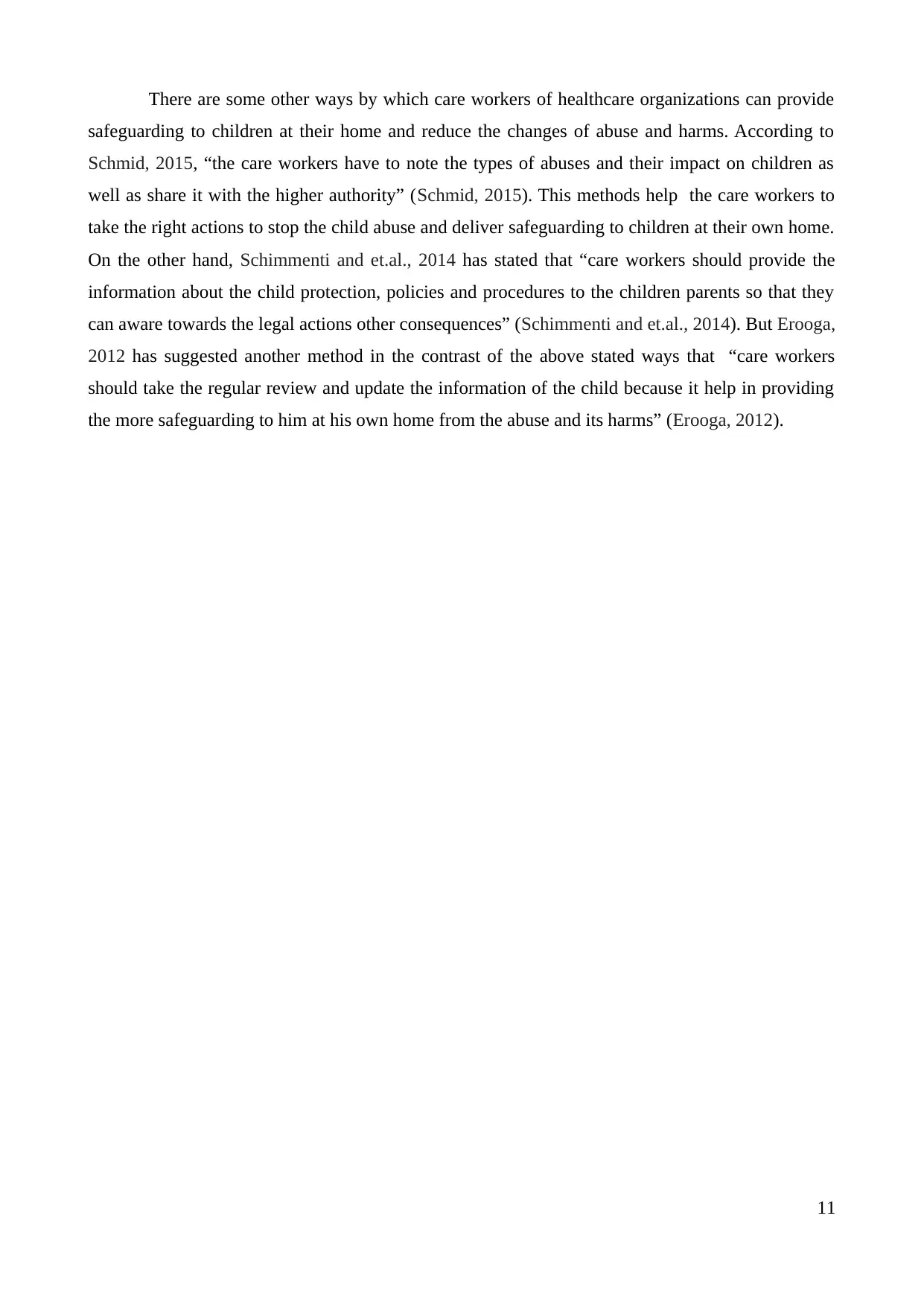
There are some other ways by which care workers of healthcare organizations can provide
safeguarding to children at their home and reduce the changes of abuse and harms. According to
Schmid, 2015, “the care workers have to note the types of abuses and their impact on children as
well as share it with the higher authority” (Schmid, 2015). This methods help the care workers to
take the right actions to stop the child abuse and deliver safeguarding to children at their own home.
On the other hand, Schimmenti and et.al., 2014 has stated that “care workers should provide the
information about the child protection, policies and procedures to the children parents so that they
can aware towards the legal actions other consequences” (Schimmenti and et.al., 2014). But Erooga,
2012 has suggested another method in the contrast of the above stated ways that “care workers
should take the regular review and update the information of the child because it help in providing
the more safeguarding to him at his own home from the abuse and its harms” (Erooga, 2012).
11
safeguarding to children at their home and reduce the changes of abuse and harms. According to
Schmid, 2015, “the care workers have to note the types of abuses and their impact on children as
well as share it with the higher authority” (Schmid, 2015). This methods help the care workers to
take the right actions to stop the child abuse and deliver safeguarding to children at their own home.
On the other hand, Schimmenti and et.al., 2014 has stated that “care workers should provide the
information about the child protection, policies and procedures to the children parents so that they
can aware towards the legal actions other consequences” (Schimmenti and et.al., 2014). But Erooga,
2012 has suggested another method in the contrast of the above stated ways that “care workers
should take the regular review and update the information of the child because it help in providing
the more safeguarding to him at his own home from the abuse and its harms” (Erooga, 2012).
11
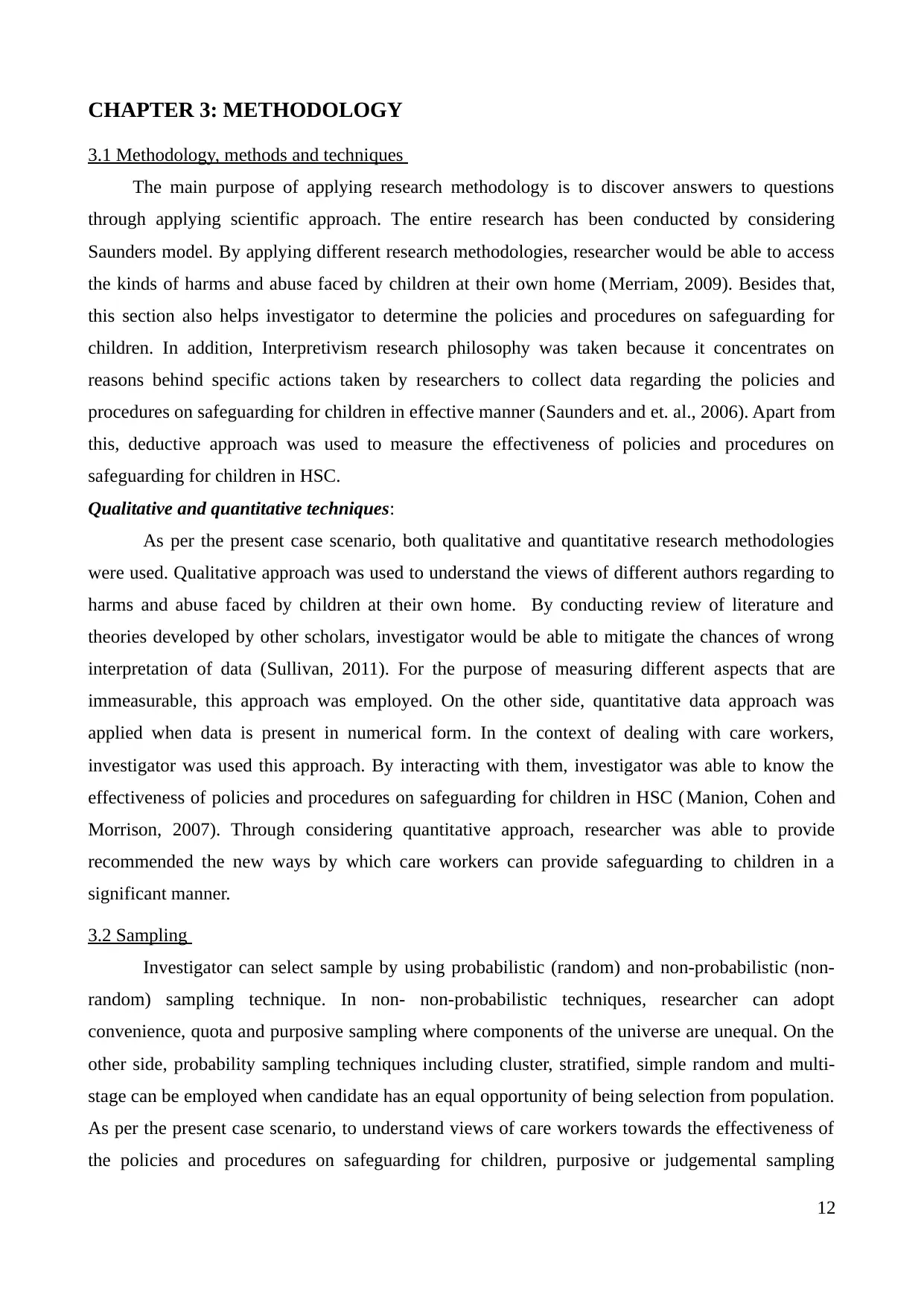
CHAPTER 3: METHODOLOGY
3.1 Methodology, methods and techniques
The main purpose of applying research methodology is to discover answers to questions
through applying scientific approach. The entire research has been conducted by considering
Saunders model. By applying different research methodologies, researcher would be able to access
the kinds of harms and abuse faced by children at their own home (Merriam, 2009). Besides that,
this section also helps investigator to determine the policies and procedures on safeguarding for
children. In addition, Interpretivism research philosophy was taken because it concentrates on
reasons behind specific actions taken by researchers to collect data regarding the policies and
procedures on safeguarding for children in effective manner (Saunders and et. al., 2006). Apart from
this, deductive approach was used to measure the effectiveness of policies and procedures on
safeguarding for children in HSC.
Qualitative and quantitative techniques:
As per the present case scenario, both qualitative and quantitative research methodologies
were used. Qualitative approach was used to understand the views of different authors regarding to
harms and abuse faced by children at their own home. By conducting review of literature and
theories developed by other scholars, investigator would be able to mitigate the chances of wrong
interpretation of data (Sullivan, 2011). For the purpose of measuring different aspects that are
immeasurable, this approach was employed. On the other side, quantitative data approach was
applied when data is present in numerical form. In the context of dealing with care workers,
investigator was used this approach. By interacting with them, investigator was able to know the
effectiveness of policies and procedures on safeguarding for children in HSC (Manion, Cohen and
Morrison, 2007). Through considering quantitative approach, researcher was able to provide
recommended the new ways by which care workers can provide safeguarding to children in a
significant manner.
3.2 Sampling
Investigator can select sample by using probabilistic (random) and non-probabilistic (non-
random) sampling technique. In non- non-probabilistic techniques, researcher can adopt
convenience, quota and purposive sampling where components of the universe are unequal. On the
other side, probability sampling techniques including cluster, stratified, simple random and multi-
stage can be employed when candidate has an equal opportunity of being selection from population.
As per the present case scenario, to understand views of care workers towards the effectiveness of
the policies and procedures on safeguarding for children, purposive or judgemental sampling
12
3.1 Methodology, methods and techniques
The main purpose of applying research methodology is to discover answers to questions
through applying scientific approach. The entire research has been conducted by considering
Saunders model. By applying different research methodologies, researcher would be able to access
the kinds of harms and abuse faced by children at their own home (Merriam, 2009). Besides that,
this section also helps investigator to determine the policies and procedures on safeguarding for
children. In addition, Interpretivism research philosophy was taken because it concentrates on
reasons behind specific actions taken by researchers to collect data regarding the policies and
procedures on safeguarding for children in effective manner (Saunders and et. al., 2006). Apart from
this, deductive approach was used to measure the effectiveness of policies and procedures on
safeguarding for children in HSC.
Qualitative and quantitative techniques:
As per the present case scenario, both qualitative and quantitative research methodologies
were used. Qualitative approach was used to understand the views of different authors regarding to
harms and abuse faced by children at their own home. By conducting review of literature and
theories developed by other scholars, investigator would be able to mitigate the chances of wrong
interpretation of data (Sullivan, 2011). For the purpose of measuring different aspects that are
immeasurable, this approach was employed. On the other side, quantitative data approach was
applied when data is present in numerical form. In the context of dealing with care workers,
investigator was used this approach. By interacting with them, investigator was able to know the
effectiveness of policies and procedures on safeguarding for children in HSC (Manion, Cohen and
Morrison, 2007). Through considering quantitative approach, researcher was able to provide
recommended the new ways by which care workers can provide safeguarding to children in a
significant manner.
3.2 Sampling
Investigator can select sample by using probabilistic (random) and non-probabilistic (non-
random) sampling technique. In non- non-probabilistic techniques, researcher can adopt
convenience, quota and purposive sampling where components of the universe are unequal. On the
other side, probability sampling techniques including cluster, stratified, simple random and multi-
stage can be employed when candidate has an equal opportunity of being selection from population.
As per the present case scenario, to understand views of care workers towards the effectiveness of
the policies and procedures on safeguarding for children, purposive or judgemental sampling
12
⊘ This is a preview!⊘
Do you want full access?
Subscribe today to unlock all pages.

Trusted by 1+ million students worldwide
1 out of 22
Related Documents
Your All-in-One AI-Powered Toolkit for Academic Success.
+13062052269
info@desklib.com
Available 24*7 on WhatsApp / Email
![[object Object]](/_next/static/media/star-bottom.7253800d.svg)
Unlock your academic potential
Copyright © 2020–2025 A2Z Services. All Rights Reserved. Developed and managed by ZUCOL.





